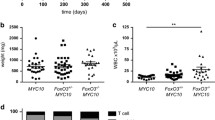Abstract
The v-Rel oncoprotein belongs to the Rel/NF-κB family of transcription factors. It transforms chicken lymphoid cells in vitro and induces fatal lymphomas in vivo. In this study, we used a tetracycline-regulated system to characterize the role of v-Rel in cell transformation. We show that the continued expression of v-Rel is necessary to maintain the viability of transformed lymphoid cells and enables primary spleen cells to escape apoptosis in vitro culture. In agreement with a possible role for v-Rel in the inhibition of programmed cell death, its inducible expression in HeLa cells prevented TNFα-induced apoptosis. While the repression of v-Rel was accompanied by the rapid degradation of IκBα, changes in the steady-state levels of the apoptosis inhibitors Bcl-2 and Bcl-XL were only observed following the onset of cell death in transformed lymphoid cells. This suggests that the anti-apoptotic activity of v-Rel may affect other apoptosis inhibitors or other factors in the death pathway. Together, these findings demonstrate that v-Rel blocks apoptosis and suggest that this activity may be an important component of its transforming function.
Similar content being viewed by others
Author information
Authors and Affiliations
Rights and permissions
About this article
Cite this article
Zong, WX., Farrell, M., Bash, J. et al. v-Rel prevents apoptosis in transformed lymphoid cells and blocks TNFα-induced cell death. Oncogene 15, 971–980 (1997). https://doi.org/10.1038/sj.onc.1201266
Received:
Revised:
Accepted:
Issue Date:
DOI: https://doi.org/10.1038/sj.onc.1201266
- Springer Nature Limited
Keywords
This article is cited by
-
The suppression of SH3BGRL is important for v-Rel-mediated transformation
Oncogene (2006)
-
To be, or not to be: NF-κB is the answer – role of Rel/NF-κB in the regulation of apoptosis
Oncogene (2003)
-
Aberrant rel/nfkb genes and activity in human cancer
Oncogene (1999)
-
Multiple mutations contribute to the oncogenicity of the retroviral oncoprotein v-Rel
Oncogene (1999)




